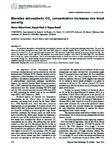Please use this identifier to cite or link to this item:
http://www.alice.cnptia.embrapa.br/alice/handle/doc/963214| Title: | Elevated atmospheric CO2 concentration increases rice blast severity. |
| Authors: | GÓRIA, M. M.  GHINI, R.   BETTIOL, W.   |
| Affiliation: | MARINA MELONI GÓRIA, FCA-UNESP; RAQUEL GHINI, CNPMA; WAGNER BETTIOL, CNPMA. |
| Date Issued: | 2013 |
| Citation: | Tropical Plant Pathology, Brasília, DF, v. 38, n. 3, p. 253-257, 2013. |
| Description: | Abstract: The predicted atmospheric carbon dioxide concentration?s increases are likely to alter plant-pathogen interactions. To assess the effects on rice blast, during three years (2007, 2008 and 2009), three rice cultivars (Agulha Precoce, Shao Tiao Tsao and Caloro) were exposed to elevated CO2 air concentration (approximately 100 - 300 ?mol mol-1 higher than ambient) in open-top chamber facility. The disease was more severe under high CO2 concentration. Area under disease progress curve was 35.43 under high CO2 concentration and 17.48 for the current concentration. Leaves of treated plants tended to contain less silicon. In 2009, plant height of two cultivars was greater in high CO2. Understanding and predicting the climate-driven changes in the agroecosystem may allow the development of adaptation strategies in order to minimize crop losses. |
| Thesagro: | Brusone Arroz Doença de planta Dióxido de carbono Clima Mudança Climática |
| NAL Thesaurus: | Carbon dioxide Climate change Plant diseases and disorders Blast disease Rice |
| Keywords: | Piricularia oryzae |
| Type of Material: | Artigo de periódico |
| Access: | openAccess |
| Appears in Collections: | Artigo em periódico indexado (CNPMA)  |
Files in This Item:
| File | Description | Size | Format | |
|---|---|---|---|---|
| 2013AP17.pdf | 19,95 MB | Adobe PDF |  View/Open |









